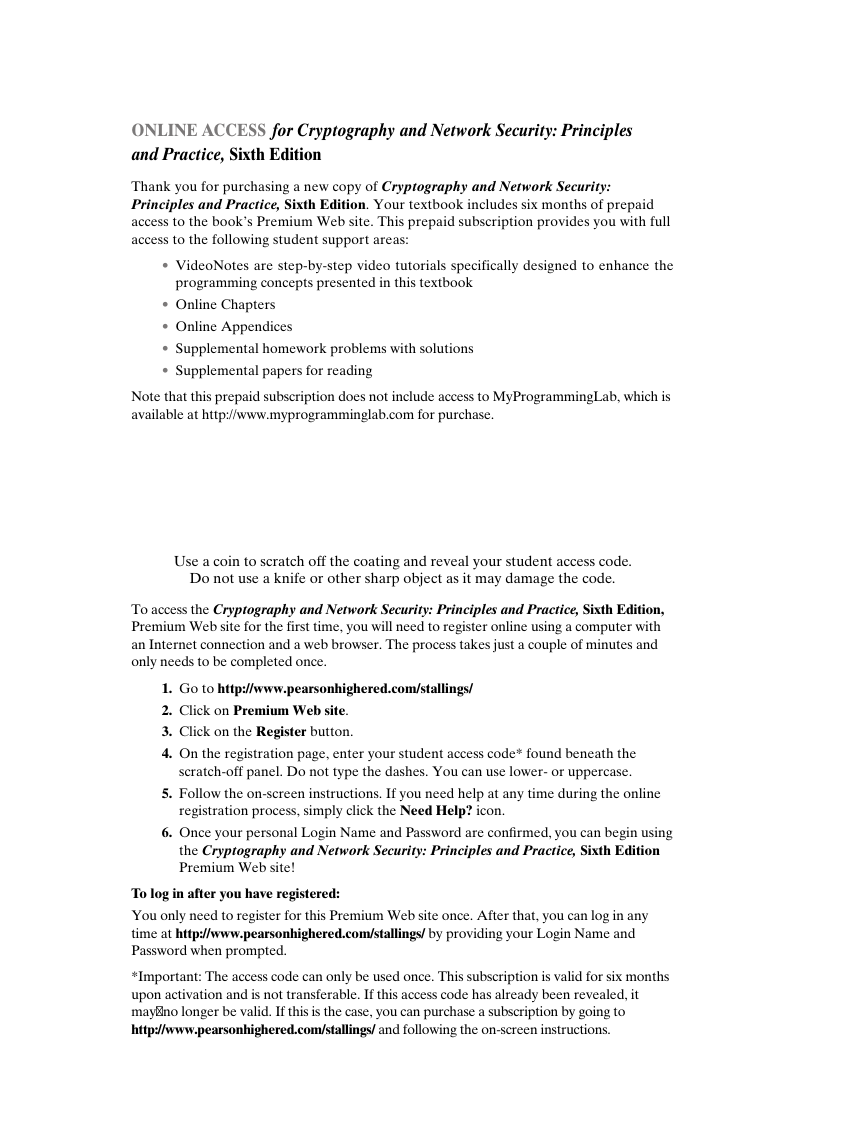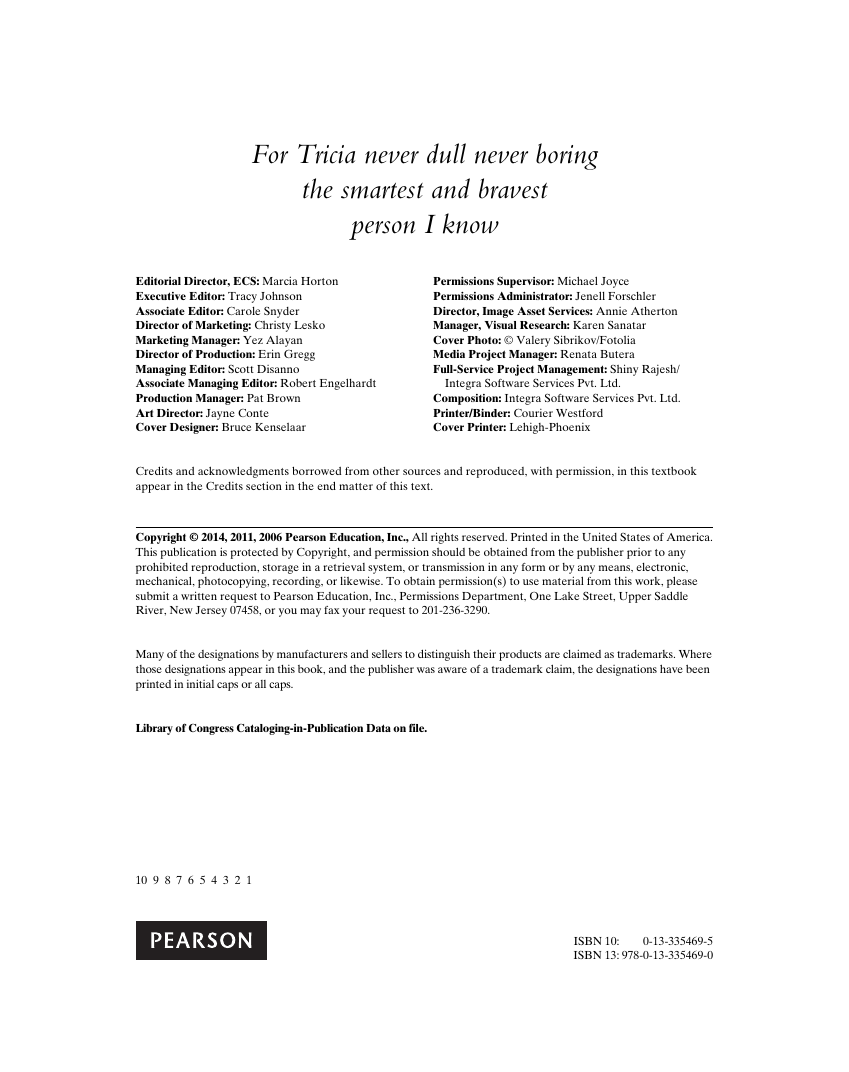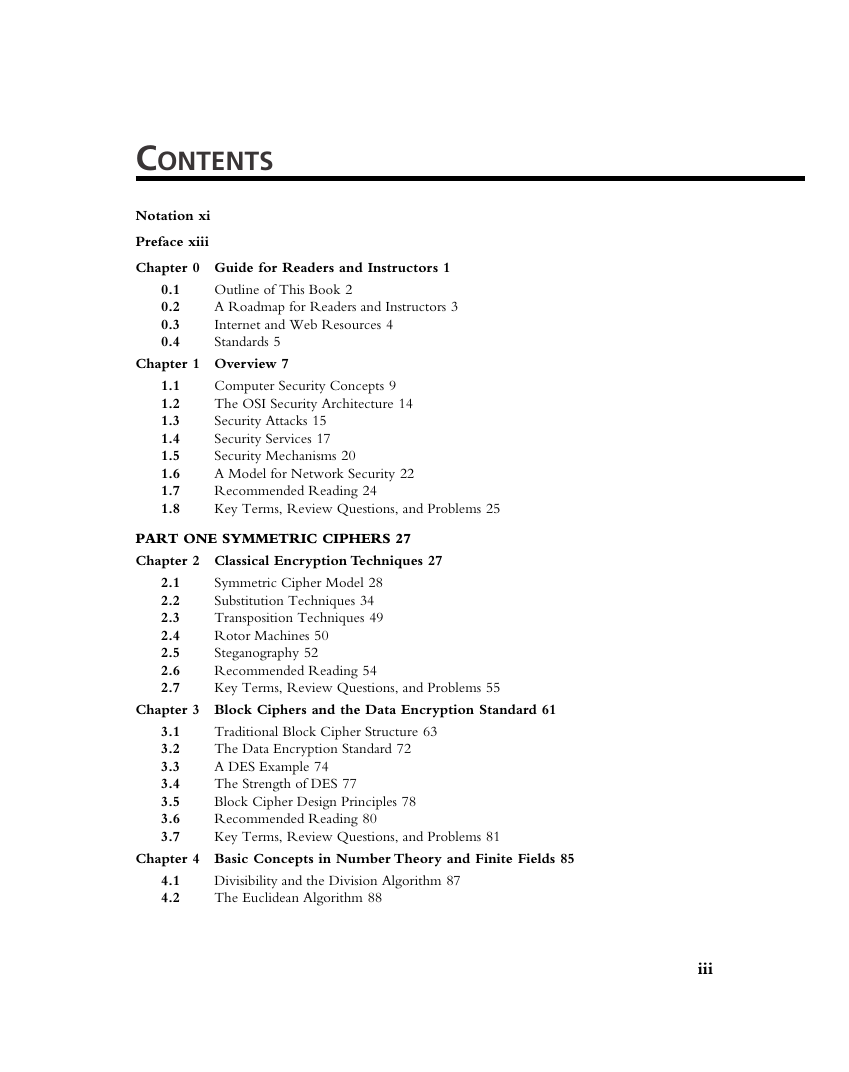Cover
Title Page
Copyright Page
Contents
Notation
Preface
Chapter 0 Guide for Readers and Instructors
0.1 Outline of This Book
0.2 A Roadmap for Readers and Instructors
0.3 Internet and Web Resources
0.4 Standards
Chapter 1 Overview
1.1 Computer Security Concepts
1.2 The OSI Security Architecture
1.3 Security Attacks
1.4 Security Services
1.5 Security Mechanisms
1.6 A Model for Network Security
1.7 Recommended Reading
1.8 Key Terms, Review Questions, and Problems
PART ONE: SYMMETRIC CIPHERS
Chapter 2 Classical Encryption Techniques
2.1 Symmetric Cipher Model
2.2 Substitution Techniques
2.3 Transposition Techniques
2.4 Rotor Machines
2.5 Steganography
2.6 Recommended Reading
2.7 Key Terms, Review Questions, and Problems
Chapter 3 Block Ciphers and the Data Encryption Standard
3.1 Traditional Block Cipher Structure
3.2 The Data Encryption Standard
3.3 A DES Example
3.4 The Strength of DES
3.5 Block Cipher Design Principles
3.6 Recommended Reading
3.7 Key Terms, Review Questions, and Problems
Chapter 4 Basic Concepts in Number Theory and Finite Fields
4.1 Divisibility and the Division Algorithm
4.2 The Euclidean Algorithm
4.3 Modular Arithmetic
4.4 Groups, Rings, and Fields
4.5 Finite Fields of the Form GF(p)
4.6 Polynomial Arithmetic
4.7 Finite Fields of the Form GF(2[sup(n)])
4.8 Recommended Reading
4.9 Key Terms, Review Questions, and Problems
Appendix 4A: The Meaning of mod
Chapter 5 Advanced Encryption Standard
5.1 Finite Field Arithmetic
5.2 AES Structure
5.3 AES Transformation Functions
5.4 AES Key Expansion
5.5 An AES Example
5.6 AES Implementation
5.7 Recommended Reading
5.8 Key Terms, Review Questions, and Problems
Appendix 5A: Polynomials with Coefficients in GF(2[sup(8)])
Appendix 5B: Simplified AES
Chapter 6 Block Cipher Operation
6.1 Multiple Encryption and Triple DES
6.2 Electronic Code book
6.3 Cipher Block Chaining Mode
6.4 Cipher Feedback Mode
6.5 Output Feedback Mode
6.6 Counter Mode
6.7 XTS-AES Mode for Block-Oriented Storage Devices
6.8 Recommended Reading
6.9 Key Terms, Review Questions, and Problems
Chapter 7 Pseudorandom Number Generation and Stream Ciphers
7.1 Principles of Pseudorandom Number Generation
7.2 Pseudorandom Number Generators
7.3 Pseudorandom Number Generation Using a Block Cipher
7.4 Stream Ciphers
7.5 RC4
7.6 True Random Number Generators
7.7 Recommended Reading
7.8 Key Terms, Review Questions, and Problems
PART TWO: ASYMMETRIC CIPHERS
Chapter 8 More Number Theory
8.1 Prime Numbers
8.2 Fermat’s and Euler’s Theorems
8.3 Testing for Primality
8.4 The Chinese Remainder Theorem
8.5 Discrete Logarithms
8.6 Recommended Reading
8.7 Key Terms, Review Questions, and Problems
Chapter 9 Public-Key Cryptography and RSA
9.1 Principles of Public-Key Cryptosystems
9.2 The RSA Algorithm
9.3 Recommended Reading
9.4 Key Terms, Review Questions, and Problems
Appendix 9A: The Complexity of Algorithms
Chapter 10 Other Public-Key Cryptosystems
10.1 Diffie-Hellman Key Exchange
10.2 Elgamal Cryptographic System
10.3 Elliptic Curve Arithmetic
10.4 Elliptic Curve Cryptography
10.5 Pseudorandom Number Generation Based on an Asymmetric Cipher
10.6 Recommended Reading
10.7 Key Terms, Review Questions, and Problems
PART THREE: CRYPTOGRAPHIC DATA INTERGRITY ALGORITHMS
Chapter 11 Cryptographic Hash Functions
11.1 Applications of Cryptographic Hash Functions
11.2 Two Simple Hash Functions
11.3 Requirements and Security
11.4 Hash Functions Based on Cipher Block Chaining
11.5 Secure Hash Algorithm (SHA)
11.6 SHA-3
11.7 Recommended Reading
11.8 Key Terms, Review Questions, and Problems
Chapter 12 Message Authentication Codes
12.1 Message Authentication Requirements
12.2 Message Authentication Functions
12.3 Requirements for Message Authentication Codes
12.4 Security of MACs
12.5 MACs Based on Hash Functions: HMAC
12.6 MACs Based on Block Ciphers: DAA and CMAC
12.7 Authenticated Encryption: CCM and GCM
12.8 Key Wrapping
12.9 Pseudorandom Number Generation using Hash Functions and MACs
12.10 Recommended Reading
12.11 Key Terms, Review Questions, and Problems
Chapter 13 Digital Signatures
13.1 Digital Signatures
13.2 Elgamal Digital Signature Scheme
13.3 Schnorr Digital Signature Scheme
13.4 NIST Digital Signature Algorithm
13.5 Elliptic Curve Digital Signature Algorithm
13.6 RSA-PSS Digital Signature Algorithm
13.7 Recommended Reading
13.8 Key Terms, Review Questions, and Problems
PART FOUR: MUTUAL TRUST
Chapter 14 Key Management and Distribution
14.1 Symmetric Key Distribution Using Symmetric Encryption
14.2 Symmetric Key Distribution Using Asymmetric Encryption
14.3 Distribution of Public Keys
14.4 X.509 Certificates
14.5 Public-Key Infrastructure
14.6 Recommended Reading
14.7 Key Terms, Review Questions, and Problems
Chapter 15 User Authentication
15.1 Remote User-Authentication Principles
15.2 Remote User-Authentication Using Symmetric Encryption
15.3 Kerberos
15.4 Remote User Authentication Using Asymmetric Encryption
15.5 Federated Identity Management
15.6 Personal Identity Verification
15.7 Recommended Reading
15.8 Key Terms, Review Questions, and Problems
PART FIVE: NETWORK AND INTERNET SECURITY
Chapter 16 Network Access Control and Cloud Security
16.1 Network Access Control
16.2 Extensible Authentication Protocol
16.3 IEEE 802.1X Port-Based Network Access Control
16.4 Cloud Computing
16.5 Cloud Security Risks and Countermeasures
16.6 Data Protection in the Cloud
16.7 Cloud Security as a Service
16.8 Recommended Reading
16.9 Key Terms, Review Questions, and Problems
Chapter 17 Transport-Level Security
17.1 Web Security Considerations
17.2 Secure Sockets Layer
17.3 Transport Layer Security
17.4 HTTPS
17.5 Secure Shell (SSH)
17.6 Recommended Reading
17.7 Key Terms, Review Questions, and Problems
Chapter 18 Wireless Network Security
18.1 Wireless Security
18.2 Mobile Device Security
18.3 IEEE 802.11 Wireless LAN Overview
18.4 IEEE 802.11i Wireless LAN Security
18.5 Recommended Reading
18.6 Key Terms, Review Questions, and Problems
Chapter 19 Electronic Mail Security
19.1 Pretty Good Privacy
19.2 S/MIME
19.3 DomainKeys Identified Mail
19.4 Recommended Reading
19.5 Key Terms, Review Questions, and Problems
Appendix 19A: Radix-64 Conversion
Chapter 20 IP Security
20.1 IP Security Overview
20.2 IP Security Policy
20.3 Encapsulating Security Payload
20.4 Combining Security Associations
20.5 Internet Key Exchange
20.6 Cryptographic Suites
20.7 Recommended Reading
20.8 Key Terms, Review Questions, and Problems
APPENDICES
Appendix A: Projects for Teaching Cryptography and Network Security
A.1 Sage Computer Algebra Projects
A.2 Hacking Project
A.3 Block Cipher Projects
A.4 Laboratory Exercises
A.5 Research Projects
A.6 Programming Projects
A.7 Practical Security Assessments
A.8 Firewall Projects
A.9 Case Studies
A.10 Writing Assignments
A.11 Reading/Report Assignments
A.12 Discussion Topics
Appendix B: Sage Examples
B.1 Linear Algebra and Matrix Functionality
B.2 Chapter 2: Classical Encryption
B.3 Chapter 3: Block Ciphers and the Data Encryption Standard
B.4 Chapter 4: Basic Concepts in Number Theory and Finite Fields
B.5 Chapter 5: Advanced Encryption Standard
B.6 Chapter 6: Pseudorandom Number Generation and Stream Ciphers
B.7 Chapter 8: Number Theory
B.8 Chapter 9: Public-Key Cryptography and RSA
B.9 Chapter 10: Other Public-Key Cryptosystems
B.10 Chapter 11: Cryptographic Hash Functions
B.11 Chapter 13: Digital Signatures
References
Credits
Index
A
B
C
D
E
F
G
H
I
K
L
M
N
O
P
Q
R
S
T
U
V
W
X
Z
















 2023年江西萍乡中考道德与法治真题及答案.doc
2023年江西萍乡中考道德与法治真题及答案.doc 2012年重庆南川中考生物真题及答案.doc
2012年重庆南川中考生物真题及答案.doc 2013年江西师范大学地理学综合及文艺理论基础考研真题.doc
2013年江西师范大学地理学综合及文艺理论基础考研真题.doc 2020年四川甘孜小升初语文真题及答案I卷.doc
2020年四川甘孜小升初语文真题及答案I卷.doc 2020年注册岩土工程师专业基础考试真题及答案.doc
2020年注册岩土工程师专业基础考试真题及答案.doc 2023-2024学年福建省厦门市九年级上学期数学月考试题及答案.doc
2023-2024学年福建省厦门市九年级上学期数学月考试题及答案.doc 2021-2022学年辽宁省沈阳市大东区九年级上学期语文期末试题及答案.doc
2021-2022学年辽宁省沈阳市大东区九年级上学期语文期末试题及答案.doc 2022-2023学年北京东城区初三第一学期物理期末试卷及答案.doc
2022-2023学年北京东城区初三第一学期物理期末试卷及答案.doc 2018上半年江西教师资格初中地理学科知识与教学能力真题及答案.doc
2018上半年江西教师资格初中地理学科知识与教学能力真题及答案.doc 2012年河北国家公务员申论考试真题及答案-省级.doc
2012年河北国家公务员申论考试真题及答案-省级.doc 2020-2021学年江苏省扬州市江都区邵樊片九年级上学期数学第一次质量检测试题及答案.doc
2020-2021学年江苏省扬州市江都区邵樊片九年级上学期数学第一次质量检测试题及答案.doc 2022下半年黑龙江教师资格证中学综合素质真题及答案.doc
2022下半年黑龙江教师资格证中学综合素质真题及答案.doc